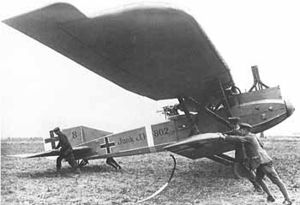Junkers J.I
| J.I | |
|---|---|
 |
|
| Role | Observation and liaison aircraft |
| Manufacturer | Junkers |
| Designer | Otto Mader |
| First flight | 28 January 1917 |
| Introduction | 1917 |
| Retired | 1919 |
| Primary user | Luftstreitkräfte |
| Number built | 227 |
The Junkers J.I (manufacturer's designation J 4) was a German "J-class" armored sesquiplane of World War I, developed for low-level ground attack, observation and Army cooperation. It is especially noteworthy as being the first all-metal aircraft to enter mass production; the aircraft's metal construction and heavy armour was an effective shield against small arms fire over the battlefield.
In an extremely advanced design, a single-unit steel "bathtub" that ran from just behind the propeller to the rear crew position acted not only as armour, but also as both the main fuselage structure and engine mounting in one unit, engine access being provided by twin vertically-hinged, aft-swinging triple-piece armor-steel panels, one on either side of the nose. The armour was 5 millimetres (0.20 in) thick and weighed 470 kilograms (1,040 lb). It protected the crew, the engine, the fuel tanks, and radio equipment (when fitted). The flight control surfaces were connected to the aircraft's controls by push-rods and bellcranks – not with the usual steel cable control connections of the era – as push-rods were less likely to be severed by ground fire.
There was a significant size difference between the upper and lower wings – the upper wing had a total area of 35.89 m2 (386.3 sq ft), over double the total area of the lower wing – 13.68 m2 (147.3 sq ft). This is a form of biplane known as a Sesquiplane.
The aircraft had two fuel tanks with a total capacity of around 120 litres (32 US gal). The main tank (divided into two parts for redundancy) was supplemented by a smaller, 30-litre (7.9 US gal) "gravity tank". This was intended to supply fuel to the engine by gravity feed in the event of an engine fuel pump failure; it contained enough fuel for thirty minutes on full power. There was a manual fuel pump for use when the gravity tank became exhausted.
...
Wikipedia
